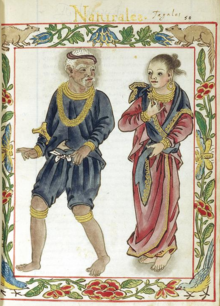Tagalog people

Maginoo (noble class) wearing blue (the distinctive colour of his class) and his wife.
|
|
| Total population | |
|---|---|
| 30 million | |
| Regions with significant populations | |
|
(Metro Manila, Calabarzon, Central Luzon, Mimaropa) |
|
| Languages | |
| Filipino (Tagalog) and other Philippine languages, English, Spanish | |
| Religion | |
|
Christianity: Catholic, Iglesia, Mormon and Protestant Islam, Buddhism, Tagalog mythology |
|
| Related ethnic groups | |
| Filipinos |
The Tagalog people is a major ethnolingustic group in the Philippines. They have a well developed society due to the cultural heartland, Manila, being the capital of the Philippines. Most of them inhabit and form a majority in the Metro Manila and Calabarzon regions of southern Luzon while a plurality in Bicol, Central Luzon and Mimaropa.
The commonly accepted origin for the endonym "Tagalog" is the term tagá-ilog, which means "people from [along] the river". An alternative theory states that the name is derived from tagá-alog, which means "people from the ford" (the prefix tagá- meaning "coming from" or "native of").
In 1821, American diplomat Edmund Roberts called the Tagalog Tagalor in his memoirs about his trips to the Philippines.
The earliest written record of the Tagalog is a 9th-century document known as the Laguna Copperplate Inscription which is about a remission of debt on behalf of the ruler of Tondo. Inscribed on it is year 822 of the Saka Era, the month of Waisaka, and the fourth day of the waning moon, which corresponds to Monday, April 21, 900 CE in the Proleptic Gregorian calendar. The writing system used is the Kawi Script, while the language is a variety of Old Malay, and contains numerous loanwords from Sanskrit and a few non-Malay vocabulary elements whose origin may be Old Javanese. Some contend it is between Old Tagalog and Old Javanese. The document states that it releases its bearers, the children of Namwaran, from a debt in gold amounting to 1 kati and 8 suwarnas (865 grams). During the reign of Sultan Bolkiah in 1485 to 1521, the Sultanate of Brunei decided to break Tondo's monopoly in the China trade by attacking Tondo and establishing the state of Selurung as a Bruneian satellite-state.
...
Wikipedia
